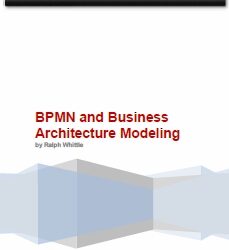This is the fourth and final article in a 4-part series of articles on architecture presented by the BAInstitiute. If the reader has not read the previous three articles in this series, the reader is encouraged to begin the series in its proper sequence.
Ralph Whittle
Member since
Jul 07, 2005

Business Process Management (BPM)
Articles by: Ralph Whittle
Real Business Architecture in Action© Part 3 of 4
Real Business Architecture in Action© Part 2 of 4
This is the second article in a 4-part series of articles on architecture presented by the BAInstitiute.
In the first article of this series, the reader was asked to visualize how to create a typical low-level workflow model from an enterprise template of architectural primitives or formally defined elements of the enterprise. In the Business Architecture (BA) tool referenced in the first article, all of these design elements were operationally current and available from the enterprise template to quickly build low-level workflows. The workflow creation was illustrated in a short youtube animation on how to use the enterprise template to assemble a generic workflow.
Real Business Architecture in Action© Part 1 of 4
This is the first article in a 4-part series presented by the BAInstitute.org.
For many new business and IT professionals entering the field of Business Architecture (BA), an exciting opportunity is at hand. However, these new entrants must consider beginning their career expanding endeavors with a clear and solid foundation in architecture principles. In this article, the reader is asked to participate in a visualization exercise in order to understand real Business Architecture in action.
Special Report: BPMN and Business Architecture Modeling
This special report asks the question: “Is it possible for both the business process and Business Architecture Modeling approaches to share a common modeling language and might BPMN 2.0 satisfy both?”
Successes and Achievements
Discovering the Value Streams for an Enterprise
How does a Business Architecture (BA) team determine the value streams for their enterprise? Is there a suitable reference available in the public domain of the Web for the team to analyze? Many are familiar with and frequently use the American Productivity and Quality Center (APQC) and its Process Classification Framework (PCF), but does something comparable to the APQC-PCF[1] exist which is organized around value streams by industry? Sadly, the answer is “no.” So what approach should the BA team take and how will they determine the value streams for their enterprise?
Paying Down the Architectural Debt with the Business Architecture
Some enterprises are considering or have already taken bold initiatives to better manage their architectural debt. Architectural debt is a colorful metaphor for describing when a product, process, application, or system evolves well past the capability covered by the original architectural design.[1]
On the Edge with the Business Architecture
The title of this article may cause one to think about the “edge” in a “bleeding edge” context in that the Business Architecture (BA) represents a new high risk initiative that will most likely consume vast amounts of corporate resources in order to succeed. One might consider other similar contexts such as “cutting edge” or “leading edge,” but there is another context to consider as well. In the 21st Century we live in the Information Age which is sometimes referred to as the Computer Age or Digital Age. Apart from how one refers to
The Sum of All Business Processes Is the Business Architecture
Many business and IT professionals have realized that one simple and easy way to describe the Business Architecture (BA) is to say that it represents the “sum of all business processes” for an enterprise (or business unit). In fact some refer to this sum or integration as the “Business Process Architecture.” While this comment is basically correct, it does require a broader perspective and more detailed description.
Business Architecture and the End of Linear Thinking
One basic tenet of the Business Architecture (BA) is that it represents the enterprise wide integration of all business processes resulting in the Business Architecture model itself. Perhaps some business and IT professionals place more emphasis on the strategic BPM initiatives, but eventually; all business processes are integrated in the BA. In many cases, the strategic BPM initiatives represent key end-to-end processes or value steams; the building blocks of the enterprise. These building blocks, in a metaphorical sense, are similar to a bill of materials (BOM) fo























